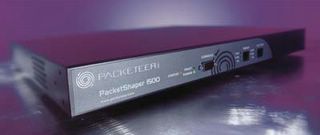
Small branch offices are particularly vulnerable to poor application performance. Business-critical applications compete with less urgent traffic for limited bandwidth on small WAN-access links. All it takes is one employee who synchronizes a laptop with the message server, and the small office's WAN link is clogged for 15 minutes, leaving applications such as Oracle or SAP floundering. PacketShaper is the solution.
PacketShaper is the bandwidth-management solution that brings predictable, efficient performance to applications running over enterprise wide-area networks (WANs) and the Internet. The PacketShaper 1500 Series is the platform designed to manage application performance for branch offices and remote sites. With PacketShaper, you can control performance to suit applications' characteristics, business' requirements, and users' needs. Then you can validate the results.
Delivering Control at the Branch
PacketShaper offers a four-step process to manage application performance: it detects and classifies network applications, analyzes network behavior, enforces policy-based bandwidth allocation, and reports on application performance.
Step One: PacketShaper automatically classifies network traffic into categories based on application, protocol, subnet, URL, and other criteria-yielding thousands of potential categories. PacketShaper goes beyond static port-matching and IP address schemes. It even classifies on the basis of layer-7 information of the OSI networking model.
Step Two: PacketShaper provides detailed analysis of application performance and network efficiency, describing peak and average bandwidth utilization, response times divided into network and server delays, top users, top web pages, top applications, and more.
Step Three: With policy-based bandwidth allocation and traffic shaping, PacketShaper protects critical applications, paces those that are less urgent, and optimizes performance of a limited WAN-access link. You specify bandwidth minimums and/or maximums on a per-session or per-application basis. PacketShaper's TCP Rate Control technology proactively prevents congestion on both inbound and outbound flows, eliminates unnecessary packet discards and retransmissions, and forces a smooth, even flow rate that maximizes throughput.
Step Four: PacketShaper's extensive reporting capabilities (reports, graphs, statistics, and SNMP MIBs) allow you to base planning activities on concrete numbers and to assess the impact of configuration changes. With service-level agreements, you can define performance standards, compare actual performance with service-level goals, and generate reports on compliance.
Match your PacketShaper to your Network
The PacketShaper 1500 Series manages application performance at offices with WAN links up to T1/E1. There are four 1500 options: a monitor-only option with no control features; an option to control a WAN link up to 128 Kbps; an option to control a WAN link up to 512 Kbps; and an option to control a WAN link up to 2 Mbps. PacketShaper is installed on the LAN segment that connects to the WAN router and supports 10/100 Mbps Ethernet LAN interfaces.
PacketShaper integrates smoothly with existing networks and requires no new protocols, router reconfiguration, topology changes, or desktop changes. Installation is simple-just plug in two cables and fill in a web-based questionnaire. PacketShaper is not a point of network failure; if PacketShaper goes down or is turned off, it acts just like a piece of cable. An easy web-based interface brings PacketShaper to any web browser with a password.
As soon as it's installed, PacketShaper automatically identifies your network traffic and measures response times. PacketShaper's suggested policies complement automatic application discovery to provide out-of-the-box policy-based management strategies. PacketShaper tells you what's on your network, makes applications perform as they should, translates network and application behavior into intuitive reports, and does it all without imposing undue overhead.
No comments:
Post a Comment